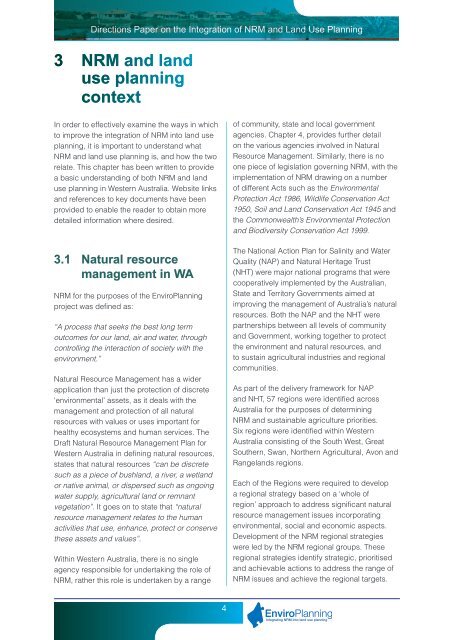Directions Paper - Western Australian Planning Commission
Directions Paper - Western Australian Planning Commission
Directions Paper - Western Australian Planning Commission
You also want an ePaper? Increase the reach of your titles
YUMPU automatically turns print PDFs into web optimized ePapers that Google loves.
<strong>Directions</strong> <strong>Paper</strong> on the Integration of NRM and Land Use <strong>Planning</strong>3 NRM and landuse planningcontextIn order to effectively examine the ways in whichto improve the integration of NRM into land useplanning, it is important to understand whatNRM and land use planning is, and how the tworelate. This chapter has been written to providea basic understanding of both NRM and landuse planning in <strong>Western</strong> Australia. Website linksand references to key documents have beenprovided to enable the reader to obtain moredetailed information where desired.3.1 Natural resourcemanagement in WANRM for the purposes of the Enviro<strong>Planning</strong>project was defined as:“A process that seeks the best long termoutcomes for our land, air and water, throughcontrolling the interaction of society with theenvironment.”Natural Resource Management has a widerapplication than just the protection of discrete‘environmental’ assets, as it deals with themanagement and protection of all naturalresources with values or uses important forhealthy ecosystems and human services. TheDraft Natural Resource Management Plan for<strong>Western</strong> Australia in defining natural resources,states that natural resources “can be discretesuch as a piece of bushland, a river, a wetlandor native animal, or dispersed such as ongoingwater supply, agricultural land or remnantvegetation”. It goes on to state that “naturalresource management relates to the humanactivities that use, enhance, protect or conservethese assets and values”.Within <strong>Western</strong> Australia, there is no singleagency responsible for undertaking the role ofNRM, rather this role is undertaken by a rangeof community, state and local governmentagencies. Chapter 4, provides further detailon the various agencies involved in NaturalResource Management. Similarly, there is noone piece of legislation governing NRM, with theimplementation of NRM drawing on a numberof different Acts such as the EnvironmentalProtection Act 1986, Wildlife Conservation Act1950, Soil and Land Conservation Act 1945 andthe Commonwealth’s Environmental Protectionand Biodiversity Conservation Act 1999.The National Action Plan for Salinity and WaterQuality (NAP) and Natural Heritage Trust(NHT) were major national programs that werecooperatively implemented by the <strong>Australian</strong>,State and Territory Governments aimed atimproving the management of Australia’s naturalresources. Both the NAP and the NHT werepartnerships between all levels of communityand Government, working together to protectthe environment and natural resources, andto sustain agricultural industries and regionalcommunities.As part of the delivery framework for NAPand NHT, 57 regions were identified acrossAustralia for the purposes of determiningNRM and sustainable agriculture priorities.Six regions were identified within <strong>Western</strong>Australia consisting of the South West, GreatSouthern, Swan, Northern Agricultural, Avon andRangelands regions.Each of the Regions were required to developa regional strategy based on a ‘whole ofregion’ approach to address significant naturalresource management issues incorporatingenvironmental, social and economic aspects.Development of the NRM regional strategieswere led by the NRM regional groups. Theseregional strategies identify strategic, prioritisedand achievable actions to address the range ofNRM issues and achieve the regional targets.4

















